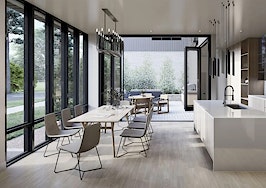Join the exceptional and become a Sotheby's International Realty agent.
Learn More
A luxury home’s ambiance, aesthetic, and visual distinctness depends on the quality of its light. But with such a wide variety of lighting fixtures to choose from, what are today’s luxury homebuyers looking for?
“Overall, buyers respond to high-quality, tasteful finishes — and lighting is no exception,” says Tyler Mearce, a Real Estate Agent at Sotheby’s International Realty’s Montecito Office. “Properly placed recessed ceiling lights and pendants over a kitchen island, well-placed table lighting, or directional lighting for art — a thoughtful plan considering all levels of lighting in a room can change the way a home looks and feels, and buyers respond to that.”
We spoke with three top agents on the lighting advice they’re giving their buyers and sellers now. Here are their tips.
Fixtures of the moment
Pendant lighting
Today, pendant lighting is the contemporary interior designer’s creative outlet. There are many types of hanging fixtures intended to make a memorable impression, yet Mearce stresses the importance of subtlety and simplicity.

Tyler Mearce
“We have seen a trend in Montecito away from traditional styles like ornate crystal and iron chandeliers to more clean-lined lighting. People are opting for modern, mid-century vintage, or fixtures that are simpler and, in some cases, more casual and fun,” he says. “The fixture should not be so overwhelming to the room that it takes away from the architecture presented. Instead, when a fixture complements a space in both design and scale, it is much more effective at selling the home as a whole.”
Jacqueline Daniels, a Broker Associate at Sierra Sotheby’s International Realty, agrees. “I would recommend matte black, less ornate light fixtures,” she says. “Clean lines and more refined industrial styles are attractive to many different types of buyers.”
While old-fashioned lighting fixtures should stay in the past, you don’t necessarily need to shy away from adding personality in the proper setting. “Over-scaled statement fixtures placed over kitchen islands, dining tables, and entry foyers are on-trend,” notes Lucy Nichols, a Broker at Aspen Snowmass Sotheby’s International Realty.
Cove lighting
It doesn’t get more subtle than cove lighting, which is generally concealed behind ledges or moldings to cast an elegant and even glow around the perimeter of a room. Bear in mind, however, that this type of lighting may require the cove to be built so that bulbs can remain hidden.
While tube lighting is a conventional choice for cove lighting, today there is a range of styles suited to unique uses. “Wall-grazing LED tape lighting can highlight art,” said Nichols. “Electric mirrors can serve as cove lighting in bathrooms, in place of dated over-the-mirror vanity fixtures.”
Recessed lighting
For ambient lighting in an open concept kitchen, living, and dining room, recessed lighting is a favorite; it can also be installed to focus on illuminating a specific area, such as an art wall.
But just as Mearce notes that overall lighting trends are moving away from the ornate, the same holds true for recessed lighting: “That is, ideally smaller and with fewer lights on the ceiling, depending on the architectural considerations.”
Architectural sconces

Jacqueline Daniels
No matter the age of your listing, sconces are a lighting fixture choice that can play to a home’s strengths, whether classic or unique, stylish or understated. They can also act as a primary lighting source or a secondary glow in lieu of lamps or tabletop fixtures.
“Architectural sconces can serve as accents in halls, creating a focal point and playful light patterns that highlight wood, tile, or stone cladding,” says Nichols. “Sconces can be relatively contemporary even in a traditional home.”
The material that your sconces are made of can bring them into the present. “Soft golds and matte black are on trend right now,” observes Daniels.
When to make a lighting change
“If there is a fixture that is particular to a client’s taste but doesn’t translate well to the average buyer for that type of home, then we may recommend replacing it,” says Mearce of the advice he gives his sellers. “Although this conversation can sometimes be awkward with a seller, it is statistically imperative to update lighting within reason. A simple coat of paint on the walls and updated light fixtures can result in an exponential return on their investment.”
He recalls a recent instance when instead of advising his client to replace a lighting fixture, he asked them to remove it from the staging since they intended to keep it when they moved. “This helped present a home that the buyer could purchase furnished without additional negotiation — saving all parties involved time and stress.”
Focus on the quality and color of the light, not just the fixture

Lucy Nichols
It might be obvious to interior designers, but it’s often overlooked by agents: light bulbs may need to be changed. “Most of the time, the fixtures have bulbs that are incorrect wattage, color, or type,” advises Nichols. “Keep the visual temperature of the lights consistent in each space — there’s nothing worse than going from yellow and dingy to white and bright. When the light is right, the mood changes and the buyer will linger longer. Having the correct light color is the same as experiencing clean windows.”
It’s all part of the staging process. “Clean the fixtures, make sure dimmers work, and angle your can lights to aim at walls and show the possibilities for art,” she adds.
Augment light with technology
Technology is an excellent way to make lighting feel modern, no matter what type of fixtures you have. “Bluetooth-controlled lighting is in-demand, and fewer switches on the wall will make an older remodeled property feel more current,” says Nichols.
If you want to change the lighting in a home, but installing new fixtures in situ isn’t feasible, don’t be afraid to go digital. “Buyers in today’s market are more often than not drawn to a home that is cosmetically updated, but when that isn’t possible, virtual staging is a big value-add,” says Mearce.
Lighting fixtures are moving towards a modern, casual feel, and simplification is helping top agents sell luxury homes. Mearce summarizes this shift succinctly: “From chandeliers to sconces, pendants to recessed lighting, simple and approachable lighting seems to be the trend.”
About Sotheby’s International Realty
Sotheby’s International Realty was founded in 1976 as a real estate service for discerning clients of Sotheby’s auction house. Today, the company’s global footprint spans 990 offices located in 72 countries and territories worldwide, including 43 company-owned brokerage offices in key metropolitan and resort markets. In February 2004, Realogy entered into a long-term strategic alliance with Sotheby’s, the operator of the auction house. The agreement provided for the licensing of the Sotheby’s International Realty name and the development of a franchise system. The franchise system is comprised of an affiliate network, where each office is independently owned and operated. Sotheby’s International Realty supports its affiliates and agents with a host of operational, marketing, recruiting, educational and business development resources. Affiliates and agents also benefit from an association with the venerable Sotheby’s auction house, established in 1744. For more information, visit www.sothebysrealty.com.
The affiliate network is operated by Sotheby’s International Realty Affiliates LLC, and the company owned brokerages are operated by Sotheby’s International Realty, Inc. Both entities are subsidiaries of Realogy Holdings Corp. (NYSE: RLGY) a global leader in real estate franchising and provider of real estate brokerage, relocation and settlement services. Sotheby’s International Realty Affiliates LLC and Sotheby’s International Realty Inc., both fully support the principles of the Fair Housing Act and the Equal Opportunity Act.
















